Atlanta turriculata
Roger R. SeapyIntroduction
Atlanta turriculata is a small species, with a maximal shell diameter about 1.8 mm. The keel is tall, rounded and transparent; keel inserts between the last and penultimate whorls in animals larger than 1.3 mm. The spire consists of 4-1/4 whorls, with the first three whorls narrow and strongly elevated, forming a "turret". A prominent spiral ridge is located on the middle of each spire whorl, beginning on the second whorl. The spire is light brown to red-brown. Eyes type a, operculum type a, and radula type I. Its geographic distribution is limited to the Pacific and Indian Oceans in tropical to subtropical waters, and it ranges from high to low abundances among sampling studies from the two oceans. In Hawaiian waters the species was recorded from the upper half of the epipelagic zone (0-200 m) during the day and migrated into the upper 100 m at night.Diagnosis
- Maximal shell diameter about 1.8 mm
- Keel tall and colorless, inserting between the last and penultimate whorls in shells >1.3 mm
- Spire narrow and elevated, with the first three whorls forming a "turret"
- Prominent spiral ridge extends outward from the middle of each spire whorl
- Color of spire light brown to red-brown
- Eyes type a
- Operculum type a
- Radula type I
Characteristics
- Shell
- Shell diameter to 1.7 mm in Hawaiian waters (Seapy, 1990a) and 1.8 mm in northern and northwestern Indian Ocean (Richter, 1974)
- Keel tall and rounded; keel starts slightly behind the shell aperture and increases gradually in height to a maximum dorsally (see title illustration and first SEM below)
- Keel inserts between the last and penultimate whorls in shells with diameters greater than 1.3 mm
 Click on an image to view larger version & data in a new window
Click on an image to view larger version & data in a new window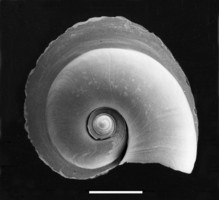
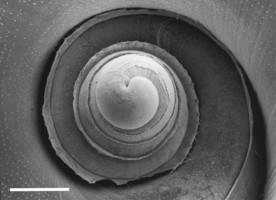 Figure. Scanning electron micrographs of the shell and shell spire in Atlanta turriculata, viewed from the right side at low (left) and high (right) magnifications. Scale bars = 0.5 and 0.1 mm, respectively. ©
Figure. Scanning electron micrographs of the shell and shell spire in Atlanta turriculata, viewed from the right side at low (left) and high (right) magnifications. Scale bars = 0.5 and 0.1 mm, respectively. © Click on an image to view larger version & data in a new window
Click on an image to view larger version & data in a new window - Spire consists of 4-1/4 whorls, with the first three whorls extending outward from the right side of the shell and forming a "turret" (hence the specific epithet, turriculata). Raised sculpture and small tubercles, or punctae, on the spire whorls; similar to those seen in A. brunnea, but fewer and far less ornate. Prominent spiral ridge centered on each spire whorl and beginning on the second whorl (click on the high magnification SEMs of the spire above and below for detail). The small tubercles on the spire continue on to the adult portion of the shell (or teleoconch), initially forming spiral rows but subsequently separating and becoming scattered (click on second SEM below for detail)
 Click on an image to view larger version & data in a new window
Click on an image to view larger version & data in a new window
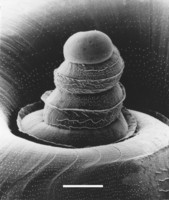
 Click on an image to view larger version & data in a new window
Click on an image to view larger version & data in a new windowFigure. Scanning electron micrographs of the shell and shell spire in Atlanta turriculata viewed at about a 60° tilt at low (left) and high (right) magnifications. Scale bars = 0.5 and 0.1 mm, respectively. © Roger R. Seapy
- Shell transparent; spire tissues light brown to reddish-brown (see title illustrations and photograph above)
- Eyes type a; lacking a transverse slit in the distal pigmented tissue
- Operculum type c (monogyre); unique to this species are two rows of short spines that spiral outward from the gyre center (illustrated also by drawings in Tokioka, 1961)
 Click on an image to view larger version & data in a new window
Click on an image to view larger version & data in a new window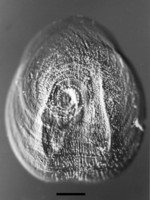

 Click on an image to view larger version & data in a new window
Click on an image to view larger version & data in a new windowFigure. Operculum of Atlanta turriculata. Left: low magnification view of operculum. Right: high magnification view of gyre region, with two spiral rows of short spines. Scale bars = 0.1 mm. ©
- Radula type I, small and ribbon shaped. Tooth morphology same as in Atlanta brunnea
Comments
Atlanta turriculata is an Indo-Pacific species, found at tropical to subtropical latitudes. It has previously been reported from the Atlantic Ocean, but these records probably represent aberrant forms with tall spires belonging to the closely-related species A. brunnea (discussed in Richter and Seapy, 1999). From quantitative studies of the atlantid faunas in the northeastern Indian Ocean (Richter, 1974) and the North Pacific off Hawaii (Seapy, 1990a, 2008), A. turriculata ranged from high to low abundances. Based on counts from five plankton cruises off leeward Hawaii (Seapy, 1990a) it was abundant, ranking second of thirteen species and accounting for 14.4% of the total. Richter (1974) reported it as moderately abundant, ranking fifth of sixteen atlantid species and accounting for 7.9% of the total. In another study off Hawaii (Seapy, 2008) it occurred in moderately low abundance in the spring, ranking seventh of 15 species and accounting for 3.8% of the total mean nighttime species densities, and in low abundance in the fall, ranking eighth of ten species and 0.6% of the total nighttime densities.
Diel vertical distribution of Atlanta turriculata was studied by Seapy (1990b and 2008) in waters off leeward Oahu, Hawaii. In the first study it was recorded between the surface and 200 m during the day and to a maximal depth of 90 m at night, with most individuals in the upper 45 m (where its mean density was 5.5 individuals per 1,000 m3). These data support an hypothesis of strong nocturnal vertical migration. In the second study a similar pattern of nocturnal migration was reported during a spring sampling period. Diel vertical distribution data were obtained at three stations located 1, 5, and 15 nmi off the coast. At the 5 and 15 nmi stations A. turriculata ranged downward to 100 m during the day and migrated into the upper 60 m at night. A maximal density of 14 individuals per 1,000 m3 was recorded at night from 0-20 m at the 15 nmi station. Comparisons of mean nighttime abundances at the three stations indicated that numbers decreased by about 20% from oceanic (15 nmi) to neritic (1 nmi) waters.
References
Richter, G. 1961. Die Radula der Atlantiden (Heteropoda, Prosobranchia) und ihre Bedeutung für die Systematik und Evolution der Familie. Zeitschrift für Morphologie und Ökologie der Tiere 50: 163-238.
Richter, G. 1974. Die Heteropoden der "Meteor"-Expedition in den Indischen Ozean, 1964/65. "Meteor" Forschungs-Ergebnisse (D) 17: 55-78.
Richter, G. and R. R. Seapy. 1999. Heteropoda, pp. 621-647. In: D. Boltovskoy (ed.), South Atlantic Zooplankton. Backhuys Publishers, Leiden.
Seapy, R. R. 1990a. The pelagic family Atlantidae (Gastropoda: Heteropoda) from Hawaiian waters: a taxonomic survey. Malacologia 32: 107-130.
Seapy, R. R. 1990b. Patterns of vertical distribution in epipelagic heteropod molluscs off Hawaii. Marine Ecology Progress Series 60: 235-246.
Seapy, R. R. 2008. Offshore-inshore and vertical distributional patterns of heteropod mollusks off leeward Oahu, Hawaii. Marine Biology 154: 985-995.
Tokioka, T. 1961. The structure of the operculum of the species of Atlantidae (Gastropoda: Heteropoda) as a taxonomic criterion, with records of some pelagic mollusks in the North Pacific. Publications of the Seto Marine Biological Laboratory 9: 267-332.
Title Illustrations

| Scientific Name | Atlanta turriculata |
|---|---|
| Location | Hawaiian waters |
| Specimen Condition | Live Specimen |
| Sex | Female |
| Life Cycle Stage | adult |
| View | right side |
| Image Use |
 This media file is licensed under the Creative Commons Attribution-NonCommercial License - Version 3.0. This media file is licensed under the Creative Commons Attribution-NonCommercial License - Version 3.0.
|
| Copyright |
©

|
| Scientific Name | Atlanta turriculata |
|---|---|
| Location | Hawaiian waters |
| Specimen Condition | Live Specimen |
| Life Cycle Stage | adult |
| View | right side |
| Size | 1.3 mm diameter (excluding keel) |
| Image Use |
 This media file is licensed under the Creative Commons Attribution-NonCommercial License - Version 3.0. This media file is licensed under the Creative Commons Attribution-NonCommercial License - Version 3.0.
|
| Copyright |
©

|
About This Page

California State University, Fullerton, California, USA
Correspondence regarding this page should be directed to Roger R. Seapy at
Page copyright © 2011
 Page: Tree of Life
Atlanta turriculata .
Authored by
Roger R. Seapy.
The TEXT of this page is licensed under the
Creative Commons Attribution License - Version 3.0. Note that images and other media
featured on this page are each governed by their own license, and they may or may not be available
for reuse. Click on an image or a media link to access the media data window, which provides the
relevant licensing information. For the general terms and conditions of ToL material reuse and
redistribution, please see the Tree of Life Copyright
Policies.
Page: Tree of Life
Atlanta turriculata .
Authored by
Roger R. Seapy.
The TEXT of this page is licensed under the
Creative Commons Attribution License - Version 3.0. Note that images and other media
featured on this page are each governed by their own license, and they may or may not be available
for reuse. Click on an image or a media link to access the media data window, which provides the
relevant licensing information. For the general terms and conditions of ToL material reuse and
redistribution, please see the Tree of Life Copyright
Policies.
- First online 15 January 2009
- Content changed 23 July 2011
Citing this page:
Seapy, Roger R. 2011. Atlanta turriculata . Version 23 July 2011. http://tolweb.org/Atlanta_turriculata/28773/2011.07.23 in The Tree of Life Web Project, http://tolweb.org/







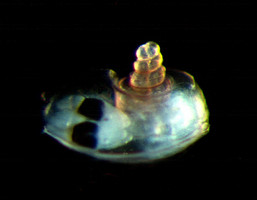
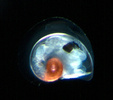
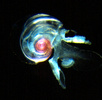


 Go to quick links
Go to quick search
Go to navigation for this section of the ToL site
Go to detailed links for the ToL site
Go to quick links
Go to quick search
Go to navigation for this section of the ToL site
Go to detailed links for the ToL site